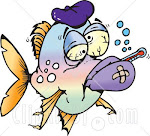Chloroquine Phosphate, Quinine Hydrochloride-Sulfate for Aquarium

Chloroquine Phosphate, Quinine Hydrochloride, & Quinine Sulfate are anti-malarial drugs that are also often very effective for single cell ecto-parasites in fish, especially Cryptocaryon, Oodinium, Brooklynella, and occasionally Ichthyophthirius Multifilis and flukes in freshwater
Quinine drugs work by causing a pH elevation in intracellular organelles of parasites, this is thought to disrupt the intracellular transport of membrane components and macromolecules, and phospholipase activity leading to cellular failure of these parasites.
Chloroquine was developed from Methylene Blue (also used starting in 1891 as an anti-malarial drug) & Quinine Sulfate in 1934. The formula of Chloroquine & Methylene Blue is also similar (MB: C16H18ClN3S / Chloroquine: C18H26ClN3).
In marine aquariums, Chloroquine Phosphate is generally the better choice over Quinine Sulfate. Chloroquine Phosphate is more effective from my experience (but also more easily and fatally overdosed). When combined in a synergistic combination with Pyrimethamine, as in the product "AAP Marex", it is even more effective for treatment of Oodinium as well as other Ectoparasites and Flukes (Pyrimethamine is generally used to treat serious parasite infections [toxoplasmosis] of the body).
Chloroquine Phospate is a drug that degrades quickly in water and must be pure to be effective, with most aquatic sources are not 99% pure.
With this in mind be mindful of the discount aquarium product seller placebo product "New Life Spectrum's Ick Shield Pellets", even assuming properly soaked with pharmaceutical grade 99% pure Chloroquine Phosphate (which is doubtful), this product simply cannot work because Chloroquine Phosphate has only been proven to successfully target the free swimming stage of EXTERNAL parasites. Which is why you must dose the powder in a hospital tank. There is no proof it is effective on trophonts feeding on the fish. Even if food soaking were somehow effective on preventing trophonts from attaching, you'd have to be sure each & every one of your fish ate it for 72 consecutive days.
Bottom line, AVOID this product.
The above referenced from this article:
Aquarium Medications Part Two; Quinine
 This combination found in AAP Marex works more quickly than chemical treatments such as copper since it immediately acts on the parasite, including in gill filaments, which copper and many other chemical treatments only act on free swimming stages of many Ectoparasites.
This combination found in AAP Marex works more quickly than chemical treatments such as copper since it immediately acts on the parasite, including in gill filaments, which copper and many other chemical treatments only act on free swimming stages of many Ectoparasites.
This synergistic Chloroquine Phosphate/Pyrimethamine combination is the fastest acting treatment I have ever used for Oodinium, although I have often found a follow up treatment with Copper or keeping the main aquarium without fish for 4 weeks will improve long term results (as copper seems to have more long term permanent killing power).
This combination of Chloroquine Phosphate/Pyrimethamine is also an excellent treatment for gill flukes in freshwater and can generally be safely combined with Praziquantel for severe cases.
Further Reading: Marine Oodinium Disease | Brooklynella & Amyloodinium Ocellatum
ADVERTISEMENT

Quinine Sulfate/Hydrochloride is useful for resistant strains of Ich (especially on scale less fish), as well as Protozoan caused sliminess of the skin and Rams disease (symptoms of whirling disease).
Also useful for resistant strains of Hexamita when combined with Metronidazole.
When Quinine Hydrochloride is combined with Malachite Green, this is one of the most effective and proven Ich and similar single cell ectoparasite treatments available! AAP Super Ich Plus is one such product that combines both and is the Ich treatment of choice for difficult cases of Ich (although for sensitive fish such as Cory Cats & Loaches this product/combination should be used at half dose and combined with Triple Sulfa).
DOSAGE : 250 mg per 10 gallons of water. Once a day for 4-5 days. Do a 25% water change before each treatment. Quinine Hydrochloride is generally safer than Quinine Sulfate more effective when available.
Quinine/Chloroquine is found in (Recommended place to purchase to support this free information & the professional aquarium keeping hobby):
*AAP Super Ich Plus (Malachite Green & Quinine Hydrochloride)
*AAP Greenex (Marine version of Super Ich Plus)
*AAP Marex
*AAP PolyGuard (as quinacrine)
Suggested other aquarium information resources & products:

Fish Diseases | How to Treat Sick Fish

Replacement Aquarium/Pond UV Bulbs
Replacement of your UV Sterilizer's UV Bulb/Lamp every six months with a true level 1 capable bulb is a MUST for optimum disease prevention and aid in Redox balance.

AAP Wonder Shells
The ONLY Authorized online seller of the full line of this unique product. Only FRESH product, not clearance product!!

AAP Hydro Sponge Filters
THE PREMIUM Aquarium Sponge Filter with as much as 5 TIMES the bio and mechanical capacity of commonly sold Chinese knock offs!!
Definitely worth the extra $1-3
Labels: Brooklynella, Copper substitute, flukes, Ich, Oodinium, scaleless fish treatment







